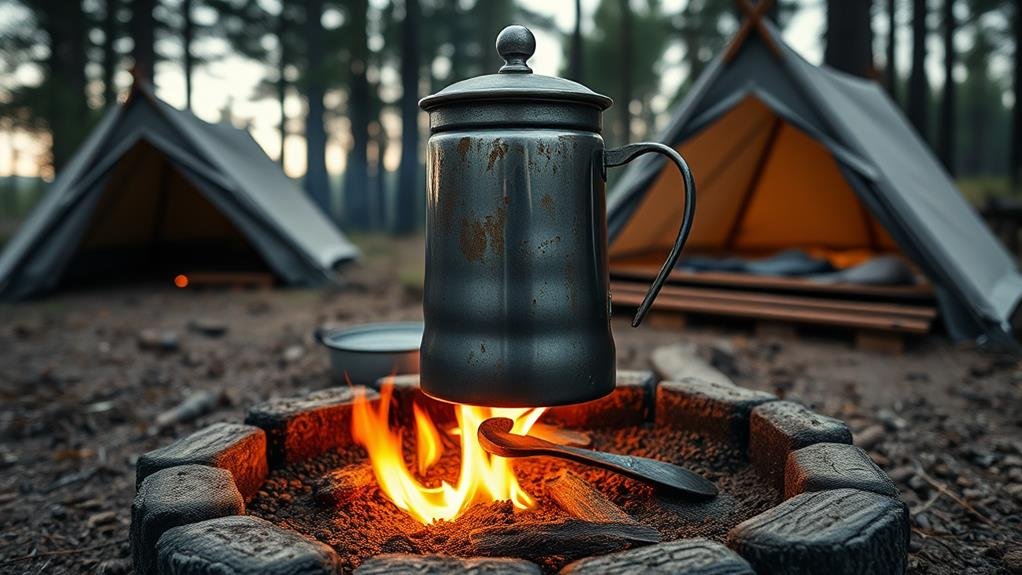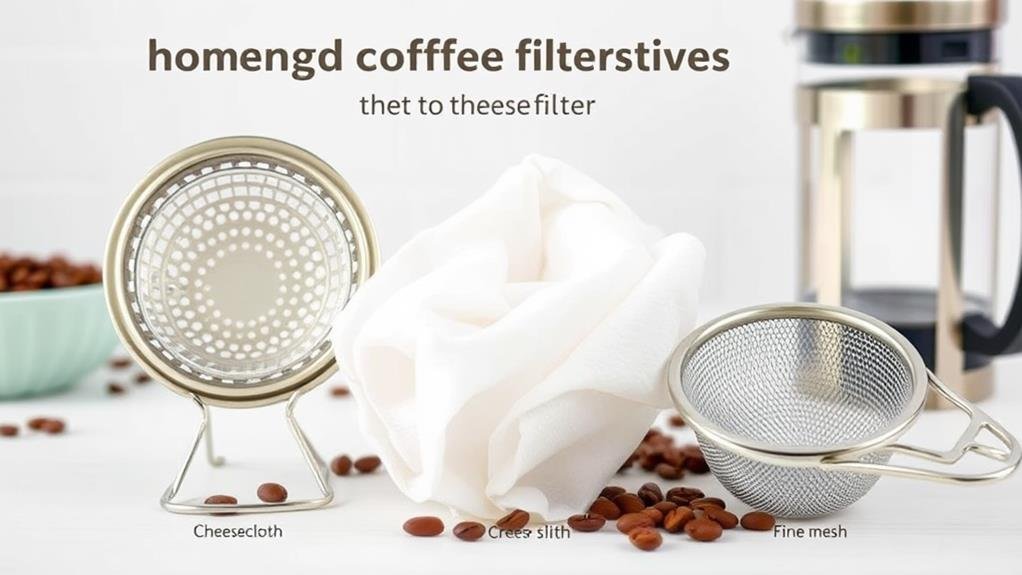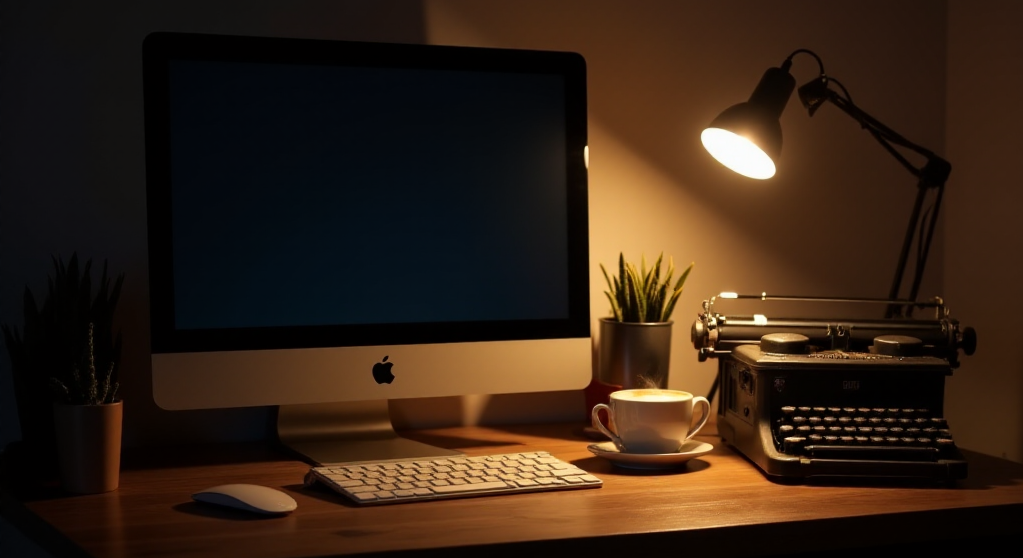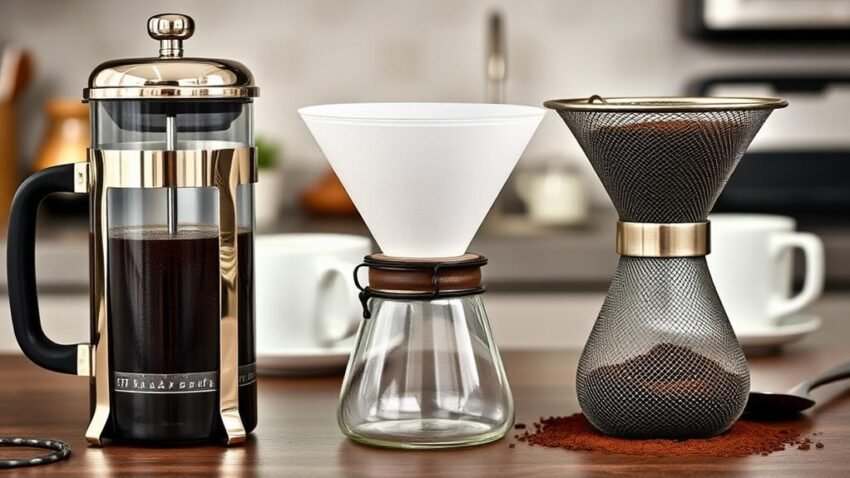As I pour the rich, aromatic coffee into my cup, the aroma fills the room, and I'm transported to a cozy morning ritual. But what if you're without a filter? No problem. There are several methods to brew perfect coffee without one. From the finely ground coffee of Turkish coffee to the coarse grounds steeped in a French press, each technique offers a unique flavor profile. Even cowboy coffee and cold brew can be made with minimal equipment. And if you're feeling creative, homemade filter alternatives like paper towels or cheesecloth can save the day. So, let's explore these options together and find your new favorite way to brew.
Turkish Coffee Method

To make Turkish coffee, you'll need a few essential items: finely ground coffee and a cezve pot, also known as an ibrik or Turkish coffee pot. This traditional brewing method involves mixing the finely ground coffee with water and sugar directly in the cezve pot. The mixture is then heated over low heat, stirring occasionally, until it starts to simmer but not boil.
Once the coffee is ready, it's poured into small cups without using a filter. This unfiltered brewing process allows the grounds to settle at the bottom of the cup, which is a key part of the Turkish coffee experience. The result is a rich and flavorful drink that many find incredibly satisfying.
When enjoying Turkish coffee, it's important to sip slowly to avoid ingesting the settled grounds. This approach helps you fully appreciate the coffee's rich flavor and aroma. Traditional Turkish coffee is renowned for its intense taste and satisfying experience, making it a beloved method for those who prefer unfiltered coffee. By following these simple steps, you can enjoy this delightful brew just like it's been made for centuries.
French Press Technique
When using the French press technique, preparing the right grounds is essential. I grind my coffee beans to a coarse consistency to avoid over-extraction and sediment in the final cup. Next, I focus on the plunger technique, ensuring it's pressed slowly and evenly to separate the grounds from the brewed coffee effectively.
Grounds Preparation
Preparing the grounds for a French press involves selecting the right grind size to achieve the finest flavor extraction. For best results, you should use coarsely ground coffee beans. This is essential because coarse grounds prevent fine particles from passing through and creating a grainy texture in your coffee.
Here are some key points to keep in mind when preparing your grounds:
- Use Coarse Grounds: Coarsely ground coffee is crucial for French press coffee to avoid over-extraction and cloudiness.
- Avoid Fine or Espresso Grounds: Fine or espresso grounds should not be used in a French press without a filter, as they can lead to an unsavory brew.
- Grind Size Matters: The right grind size ensures that the coffee grounds steep evenly in hot water, allowing for balanced extraction of flavors.
- Consistent Grind: Consistency in grind size helps in maintaining even extraction and preventing any bitter or under-extracted flavors.
Using coarsely ground coffee beans guarantees that you get a full-bodied and flavorful French press coffee with a rich aroma and minimal sediment. This method allows the coffee grounds to steep properly, extract flavor effectively, and result in a satisfying brew without any graininess. By following these guidelines for grounds preparation, you'll be able to enjoy your French press coffee at its peak.
Plunger Technique
With your coarse grounds ready, it's time to explore the plunger technique for French press coffee. This method involves steeping your coarse coffee grounds in hot water and then separating them using a plunger. The French Press technique is known for its full immersion brewing process, which means the coffee grounds are completely submerged in water throughout the brewing time.
To start, pour hot water over your coarse coffee grounds in the French Press container. Allow the mixture to steep for a few minutes, depending on your desired strength and flavor. The longer it steeps, the bolder the coffee will be.
Once you've reached your preferred brewing time, it's time to separate the grounds from the liquid. This is where the plunger comes into play. Slowly press down on the plunger until it reaches the bottom of the container, pushing all the grounds down. This action allows you to pour out a rich and flavorful cup of coffee without any grounds.
The French Press technique offers great customization, allowing you to adjust both the brewing time and coffee-to-water ratio to suit your taste preferences. This versatility makes it a popular choice among coffee enthusiasts who enjoy bold flavors without needing a filter.
Cowboy Coffee Approach

For those who crave a robust and traditional coffee experience, the cowboy coffee approach is a timeless method that delivers. This technique involves boiling water with coffee grounds in a pot without a filter, creating a strong brew that's perfect for outdoor enthusiasts.
- Boiling Water: Start by boiling water in your pot.
- Adding Coffee Grounds: Add your desired amount of coffee grounds to the boiling water.
- Steeping: Allow the mixture to steep for a few minutes to let the flavors develop.
- Straining: Use a mesh sieve or cloth to strain out the grounds if you prefer; otherwise, let them settle at the bottom of the pot.
Cowboy coffee is popular among campers due to its simplicity and lack of need for specialized equipment. You can adjust the coffee-to-water ratio and steeping time to fit your personal preferences, ensuring each brew is tailored to your taste. This traditional brewing method offers a rustic experience without any fuss over filters or machinery, making it an ideal choice for those who appreciate straightforward, bold coffee. Whether you're in the wilderness or just want a classic cup at home, cowboy coffee is a reliable and satisfying option.
Cold Brew Coffee Preparation
When I'm in the mood for a smooth, low-acidity coffee, I often turn to cold brew coffee preparation. This method is perfect for those who prefer a less acidic coffee without the need for any special equipment like filters.
To start, I measure and add ground coffee to a jar using a 1:6 coffee-to-water ratio for a strong concentrate. I then stir the mixture, seal the jar, and refrigerate it for at least 8 hours or up to 24 hours to extract the best flavor.
| Step | Description |
|---|---|
| 1. Measure | Add ground coffee to a jar using a 1:6 coffee-to-water ratio. |
| 2. Mix & Seal | Stir the mixture and seal the jar. |
| 3. Refrigerate | Refrigerate for at least 8 hours or up to 24 hours. |
| 4. Filter | Place a cloth or cheesecloth over a jug and pour the cold brew to filter out grounds. |
| 5. Serve | Dilute the concentrate with water or milk before serving over ice. |
After refrigeration, I place a cloth or cheesecloth over a jug and carefully pour the cold brew to filter out the grounds. Finally, I dilute the concentrate with water or milk before serving it over ice for a revitalizing coffee drink. Experimenting with different brewing times and ratios allows me to customize the strength and flavor profile of my cold brew coffee perfectly.
Homemade Filter Alternatives

When you're without a coffee filter, there are several homemade alternatives you can try. For instance, you can use a paper towel over the filter basket in your coffee machine for a makeshift filter. Alternatively, substituting cheesecloth or using reusable tea bags filled with coffee grounds can also work well for brewing.
Paper Towel Method
To make coffee without a traditional filter, one effective method is using a paper towel as a makeshift filter. This approach is simple and accessible, making it an excellent alternative when you don't have a coffee filter on hand.
Here's how you can do it:
- Fold the Paper Towel: Fold the paper towel to fit the filter basket in your coffee machine.
- Pre-wet the Paper Towel: Pre-wet the paper towel to prevent excessive absorption of coffee oil during brewing.
- Secure the Paper Towel: Confirm the paper towel is securely in place to prevent it from falling into the coffee grounds while brewing.
- Adjust Thickness: Modify the thickness of the paper towel to regulate the strength and clarity of your brewed coffee.
Using a paper towel as a filter is straightforward: pour water into your coffee machine, add the coffee grounds, and use the pre-wet paper towel to strain out the grounds. This method allows you to make coffee without any specialized equipment other than what you likely have at home. It's a practical solution for when you're out of traditional coffee filters or need a quick remedy for your morning cup of coffee.
Cheesecloth Filter Substitute
If you're searching for another effective method to make coffee without a traditional filter, consider using cheesecloth as a substitute. Cheesecloth serves as an excellent filter replacement due to its fine mesh, which efficiently filters out coffee grounds during the brewing process. This homemade filter option is versatile and can be easily cut to fit different brewing devices, making it highly adaptable for various methods of coffee preparation.
Cheesecloth is widely available in kitchen supply stores and is a cost-effective choice compared to purchasing traditional filters. To use it, simply cover your filter basket or container with the cheesecloth before adding the coffee grounds. This guarantees smooth and grit-free coffee, enhancing your overall brewing experience.
The DIY nature of this method allows you to customize the size and shape of the cheesecloth to suit your specific needs. By utilizing cheesecloth as a filter replacement, you can achieve high-quality filtration without depending on conventional filters. This approach not only simplifies the brewing process but also makes it more accessible and economical. With its ease of use and efficient filtration capabilities, cheesecloth stands out as a practical and dependable alternative for those looking to brew coffee without traditional filters.
Reusable Tea Bags
Using reusable tea bags as a makeshift filter is another effective way to brew coffee without relying on traditional filters. This method not only helps you avoid disposable paper filters but also offers an eco-friendly option for filtering coffee.
Here's how you can use reusable tea bags to make coffee:
- Cut open a reusable tea bag: If it's not already open, cut along one seam to create an opening for filling.
- Fill with coffee grounds: Place the desired amount of coffee grounds inside the tea bag.
- Place in cup or container: Position the filled tea bag in your coffee cup or a brewing container.
- Pour hot water: Carefully pour hot water over the coffee grounds in the tea bag and let it steep.
This DIY filter alternative is convenient and sustainable because reusable tea bags can be easily cleaned and reused multiple times. Simply wash out the grounds after use and let it dry for future brewing. This approach guarantees that you can enjoy your coffee while minimizing waste, making it a great option for those looking to make coffee without a traditional filter.
Alternative Brewing Devices
When it comes to making coffee without a filter, there are several alternative brewing devices that offer unique and flavorful experiences. If you're looking for portability and ease, consider the AeroPress or Moka Pot. These devices provide filter-free brewing options that are easy to carry and use anywhere.
For a traditional filter-free brew, Turkish coffee cezve pots are a great choice. This method involves finely grinding the coffee beans and brewing them directly in the pot, resulting in a rich, intense cup of coffee.
The French press plunger is another popular option for filter-free coffee. It separates the coffee grounds from the liquid after steeping, giving you a smooth cup without any need for filters.
If you prefer a more rustic approach, the cowboy coffee method uses just a pot and boiling water to brew your coffee directly. This method is as simple as it gets and can be done anywhere.
Lastly, if you're open to exploring different brewing times and techniques, cold brew or espresso can also serve as alternative methods for making filter-free coffee. Each of these methods offers distinct advantages and can enhance your coffee-making experience significantly.
Conclusion
By bypassing traditional filters, you can brew bold, fragrant coffee with finesse. Whether you favor the fine grind of Turkish coffee, the coarse charm of French press, the rustic simplicity of cowboy coffee, or the patient perfection of cold brew, each method offers a unique flavor profile. Homemade filter alternatives add a layer of creativity and sustainability to your routine. Explore these techniques to find the perfect blend for your palate.

